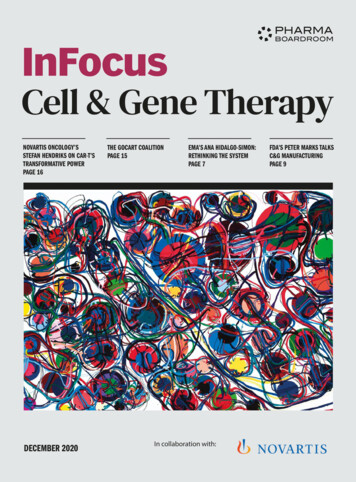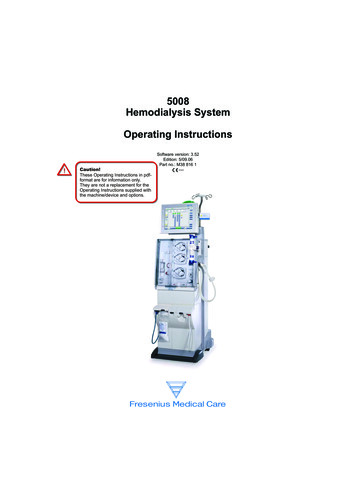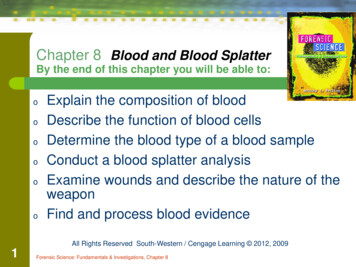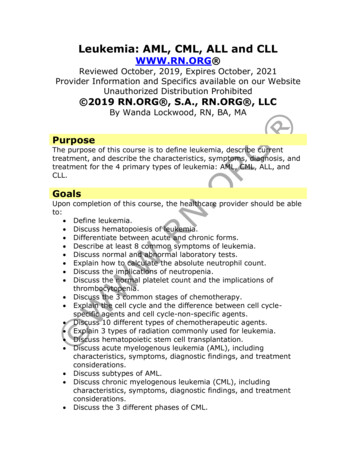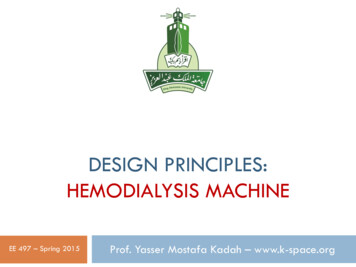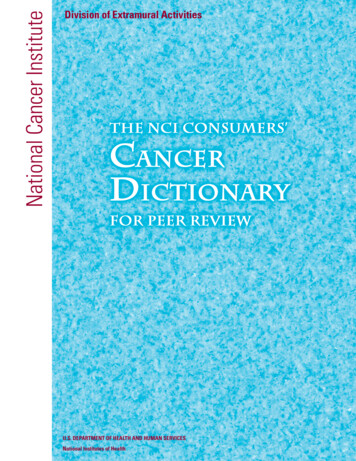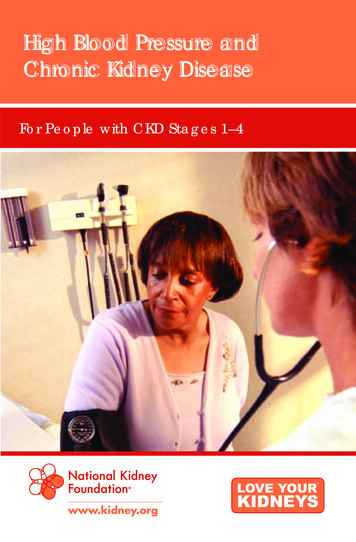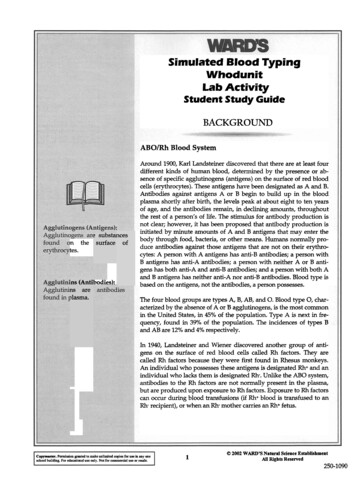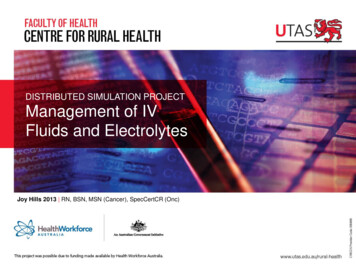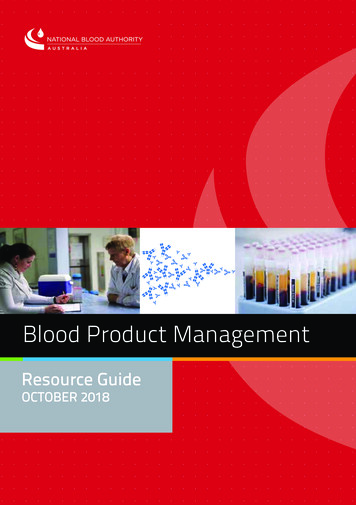
Transcription
. . . . . . . . . . . . . . . . . . . . . . . . . . . . . . . . . . . . . . . . . . . . . . . . . . . . . . . . . . . . . . . . . . . . . . . . . . . . . . . . . . . . . . . . . . . . . . . . . . . . . . . . . . . . . . . . . . . . . . . . . . . . . . . . . . . . .OCTOBER. . . . . . . . . . . . . . . . . . . . . . . . . . . . . . . . . . . . . . . . . . . . . . . . . . . . . . . . . . . . . . . . . . . . . . . . . . . . . . . . . . . . . . . . . . . . . . . . . . . . . . .2018. . . . . . . . . . . . . . . . . . .Blood Product ManagementResource Guide.
INTRODUCTIONThe National Blood Authority (NBA) is pleased to be able to assistjurisdictions and health providers to implement the requirements ofthe Australian Health Ministers’ Statement on National StewardshipExpectations on the Supply of Blood and Blood Products (theStewardship Statement).The Stewardship Statement outlines measures that all healthproviders should adopt within their organisation including therequirement to manage blood and blood products in ways that ensure: All blood products are used in a clinically appropriate mannerin accord with relevant professional guidelines and standards; Processes, programs and facilities are in place to minimisethe wastage of blood products; Facilities are accredited with the appropriate bodies to meetall quality and safety obligations; Health providers have an ordering and receipt verificationprocess in place which provides adequate financialaccountability as required by governments; and Inventory data is provided on a regular and timely basis toassist in supply and demand planning, especially in times ofnational shortages.The resources and tools in this guide can support Australian HealthProviders in aligning with the: Stewardship Statement; National Safety and Quality Health Service (NSQHS) Standard7: Blood Management; National Blood Product Management Improvement Strategy2017-21; and66 National Policy: Access to Government FundedImmunoglobulin Products in Australia.
CONTENTSGUIDANCEManaging blood and blood product inventory: guidelines for Australianhealth providers 610 tips to help manage your blood product inventory 8Module 1: Managing blood and blood product transfers 10Module 2: Managing intravenous and subcutaneous immunoglobulininventory 12Better practice case studies series: 14Better practice: National Safety and Quality Health Service (NSQHS)Standards - blood management standard 16Haemovigilance: Strategic framework for national haemovigilance 18Ensuring supply: National blood supply contingency plan 20Ig governance national immunoglobulin governance policy 22The criteria for immunoglobulin use in Australia 24Ig governance patient factsheets and resources 26SYSTEMSBloodNet: Australia’s online blood ordering and inventory managementsystem 30BloodNet: LIS Interface-laboratory information system 32BloodNet: Dashboards 34BloodNet: Reporting 36ABDR: Australian bleeding disorders registry: 38MyABDR 40BloodStar: Australia’s immunoglobulin management system 42BloodStar: Reporting 44PROMOTIONAL PRODUCTS 46Further information: 48
NATIONAL BLOOD AUTHORITY RESOURCE GUIDE OCTOBER 2018MANAGINGBLOOD ANDBLOOD PRODUCTINVENTORY:GUIDELINES FORAUSTRALIANHEALTHPROVIDERSPg.4
Good inventory management encompasses all the activities associatedwith ordering, storing, handling and issuing of blood and blood productsto optimise efficiency. Overview1. Product availability. Planning ofinventory levels held, timing ofdeliveries and order volume; and2. Product integrity. Physical andprocess control of product in yourfacility, to ensure efficient andeffective handling to maintainavailability and minimise wastage. Includes practical information onunderstanding and managing yourinventory.For more information visit www.blood.gov.au/inv-mgt-guidelineNATIONAL BLOOD AUTHORITY RESOURCE GUIDE OCTOBER 2018 Managing blood and blood productinventory is made up of two keyfactors:Pg.5
NATIONAL BLOOD AUTHORITY RESOURCE GUIDE OCTOBER 201810 TIPS TO HELPMANAGE YOURBLOOD PRODUCTINVENTORYPg.6Supporting Managing Blood ProductInventory: Guidelines for AustralianHealth Providers10tips to help manage your blood product inventorySupporting “Managing Blood Product Inventory: Guidelines for Australian Health Providers”1UNDERSTAND YOUR INVENTORYExpert inventory managers understand and regularly monitor their inventory. This includes reviewingpatterns of inventory holdings, where inventory is held, trigger levels, delivery patterns, wastage rates,and usage rates. All of this information can be examined using the BloodNet reporting features at www.blood.gov.au.23SET APPROPRIATE INVENTORY LEVELSThere is a strong relationship between inventory levels and wastage2. Hospitals and laboratories thathold more blood products relative to their average daily use often have higher wastage rates. Thetrick is to balance having sufficient inventory to meet clinical need while keeping wastage rates ata minimum. Each health provider is responsible for setting their own inventory levels and ensuringthose are appropriate.456USE OLDEST PRODUCT FIRSTWhen new product enters the inventory it should be sorted to allow it to be issued on an oldest-productfirst-out basis. Options to consider if you believe product is getting close to expiry might includetransferring to another hospital or laboratory, rotating segregated inventories where possible andhighlighting to others product that may be soon to expire.7PROVIDE EXPERT TRAININGResearch has shown that having staff that are well trained can have an overall positiveeffect on inventory management and reducing wastage1. You should ensure all staff involvedin the handling of blood products participate in a well-designed training program. Yourhospital’s medical officer induction program should include a session on blood use.KEEP PROCEDURES SIMPLESimply doing a physical count of your inventory on a regular basis and setting trigger orderinglevels can prevent staff from placing unnecessary orders and therefore having excess inventory.You can take advantage of the Minimum Order Quantity feature in BloodNet to help implementtrigger points for orders. Planning ahead can also help. If possible ask hospital clinicians toprovide you with details of blood product requirements in advance.BUILD COLLABORATIVE RELATIONSHIPSHaving good relationships with everyone involved in the supply, handling and use of blood products canhelp with managing inventory. You should encourage clinicians to understand the inventory and orderingprocess to minimise the number of unnecessary orders that could lead to product unavailability.8OPTIMISE CROSSMATCHING PROCEDURESConsider electronic crossmatching for red cells in conjunction with a Group and Screen orMaximum Blood Order Schedule (MBOS) policy for patients without clinically significantantibodies. Remember that each time blood is reserved as cross-matched for a patient;this blood is removed from available inventory. Where blood has been reserved for a patient,consider short reservation periods such as 24 hours only3.MAINTAIN ALL EQUIPMENT APPROPRIATELYAll equipment used for the storage and handling of blood products, such as refrigerators, freezersand plasma thawers should be maintained and monitored in accordance with relevant standards andguidelines4,5. You should have a plan for backup storage arrangements in the event of any equipmentfailure to prevent the loss of product.910HAVE A PLAN TO CONSERVE INVENTORY INTIMES OF SHORTAGEWhere inventory levels are running low, you should have a plan for what to doto conserve product should the need arise. Develop local policies concerningthe management of contingency events.H AVE A PATIENT BLOOD MANAGEMENT PROGRAMBefore the decision to transfuse is made, all of the risks, benefits and alternatives should beconsidered. There may be another, more appropriate product or treatment that can be used.For more informationVisit www.blood.gov.au for the Managing Blood Product Inventory: Guidelinesfor Australian Health Providers and supporting materials or emailinventory.management@blood.gov.au or call 13 000 BLOOD (13 000 25663).References1. Stanger SH, Yates N, Wilding R and Cotton S. Blood Inventory Management: Hospital BestPractice. Transfusion Medicine reviews, 2012;26:153-1632. Perera G, Hyam C, Taylor C, Chapman JF. Hospital Blood Inventory Practice: the factorsaffecting stock level and wastage. Transfusion Medicine, 2009, 19:99-1043. Blood Inventory Management Best Practices. ORBCoN, Canadian Blood Services, 20084. Requirements for Transfusion Laboratory Practice (First Edition), National PathologyAccreditation Advisory Council, 20085. Standard 7 Blood and Blood Products, Australian Commission on Safety and Quality inHealthCare, 2012Date: 20 February 2013
10 tips to help manage your blood product inventory provides a quicksummary of the inventory management information available inManaging Blood and Blood Product Inventory: Guidelines for AustralianHealth Providers. Overview The NBA can also send these to you. 10 tips can assist in wastage reductionand inventory management. Includes tips such as settingappropriate inventory levels,optimising crossmatch processes, andusing oldest product first.For more information od-product-inventoryNATIONAL BLOOD AUTHORITY RESOURCE GUIDE OCTOBER 2018 10 tips to help manage your bloodproduct inventory can be downloadedand printed as an A3 poster to displayin your laboratory as a ready reminderto staff.Pg.7
NATIONAL BLOOD AUTHORITY RESOURCE GUIDE OCTOBER 2018MODULE 1:MANAGING BLOODAND BLOOD PRODUCTTRANSFERSPg.8Supporting Managing Blood ProductInventory: Guidelines for AustralianHealth Providers.MODULE 1:MANAGINGBLOOD ANDBLOOD PRODUCTTRANSFERSTRANSFERS.
Module 1: Managing Blood and Blood Product Transfers aims toassist health providers to develop a guideline or Memorandum ofUnderstanding (MOU) to facilitate blood and blood product transferarrangements between providers and reduce wastage. Overview Memorandum of Understanding Shipper Validation plan Transfer establishment and reviewchecklist Transfer procedure checklist Blood fridge maintenance record Blood and blood product transfer form Shipper packing slip Shipper labelFor more information cope-and-introductionNATIONAL BLOOD AUTHORITY RESOURCE GUIDE OCTOBER 2018Module 1: Transfers contains eightdownloadable and modifiable templates,including:Pg.9
NATIONAL BLOOD AUTHORITY RESOURCE GUIDE OCTOBER 2018MODULE 2:MANAGINGINTRAVENOUS ting Managing Blood ProductInventory: Guidelines for AustralianHealth ProvidersMODULEMODULE 1:2:MANAGINGMANAGINGBLOODAND UNOGLOBULININVENTORY
Module 2: the Managing intravenous and subcutaneous immunoglobulininventory module aims to assist health providers to meet therequirements of the Ig Governance national policy. It describeshow to establish and manage Ig stock levels, outlines the productordering modules, identifies different methods to determine orderingrequirements and stock triggers and provides recommendations forgood practice. Overview Role of the dispenser Keeping appropriate inventory levels Ordering DispensingFor more information y-management-guidelinesNATIONAL BLOOD AUTHORITY RESOURCE GUIDE OCTOBER 2018Module 2: Managing Ig and SCIginventorycontains guidance on four keyareas:Pg.11
NATIONAL BLOOD AUTHORITY RESOURCE GUIDE OCTOBER 2018BETTER PRACTICECASE STUDIESSERIES:CASE STUDIESFROM HEALTHPROVIDERS AROUNDAUSTRALIAPg.12
The Better Practice Case Studies series identifies and documents areasof inventory management best practice in existence across the country. Overview The Better Practice Case Studiescapture relevant techniques, tools andapproaches undertaken by variousproviders across Australia. Case Studies include topics such as:Stock rotation betweenlaboratoriesyy Extended life plasmayy Steps to reduce wastageyy Point of Care Coagulation Testingyy Radio Frequency Identification(RFID)yy Public and private providerperspectives Implementation can assist providers tomeet Standard 7 of the National Safetyand Quality Health Service Standards.yyFor more information visit www.blood.gov.au/case-studiesNATIONAL BLOOD AUTHORITY RESOURCE GUIDE OCTOBER 2018 Centres can adopt and modifypractices to suit their own workplaceand conditions.Pg.13
NATIONAL BLOOD AUTHORITY RESOURCE GUIDE OCTOBER 2018BETTER PRACTICE:NATIONAL SAFETYAND QUALITYHEALTH SERVICE(NSQHS)STANDARDS - BLOODMANAGEMENTSTANDARDPg.14
The primary aim of the NSQHS Standards is to protect the public fromharm and improve the quality of health care. They describe the level ofcare that should be provided by health service organisations and thesystems that are needed to deliver such care. OverviewFor more information or to download a copy of the second edition econd-edition/NATIONAL BLOOD AUTHORITY RESOURCE GUIDE OCTOBER 2018 The Australian Commission on Safetyand Quality in Healthcare (ACSQHC)has reviewed the NSQHS Standards. The National Blood Authority (NBA)in collaboration with the ACSQHCreviewed Standard 7. The second edition of the NSQHSStandards was endorsed by HealthMinisters in June 2017, and released inNovember 2017. The second edition of the NSQHSStandards addresses gaps identifiedin the first edition. It also updates theevidence for actions, consolidates andstreamlines standards and actionsto make them clearer and easier toimplement. Assessment to the second edition willcommence from 1 January 2019.Pg.15
HAEMOVIGILANCENATIONAL BLOOD AUTHORITY RESOURCE GUIDE OCTOBER 2018STRATEGIC FRAMEWORKFOR NATIONALHAEMOVIGILANCEPg.16
The Strategic Framework for National Haemovigilance (StrategicFramework) defines the scope of national haemovigilance arrangementsto emphasise activities that contribute to national standardisation.Definition‘Haemovigilance is a set of surveillance procedures covering the entire bloodtransfusion chain, from the donation and processing of blood and its components, totheir provision and transfusion to patients, to their follow-up. It includes monitoring,reporting, investigating and analysing diverse events related to the donation,processing and transfusion of blood, as well as development and implementation ofrecommendations to prevent the occurrence or recurrence of adverse events’.(NSQHS 2017) OverviewNATIONAL BLOOD AUTHORITY RESOURCE GUIDE OCTOBER 2018 The (2017) National Safety and QualityHealth Service Standards - BloodManagement Standard requires healthservice organisations to report adverseevents as follows:» Action 7.7 The health serviceorganisation uses processes forreporting transfusion-relatedadverse events, in accordance withnational guidelines and criteria» Action 7.8 The health serviceorganisation participates inhaemovigilance activities, inaccordance with the nationalframework. The National Blood Authority(NBA) has developed reporting andgovernance frameworks for thenational reporting of Haemovigilancedata in Australia. The NBA collects, analyse andreports haemovigilance datareceived from state and territoriesat the level defined in the AustralianHaemovigilance Minimum DataSet (AHMDS). The AHMDS enablesconsistent data collection and analysisof transfusion related adverse eventsto improve the quality of nationalhaemovigilance reporting. Annual Australian HaemovigilanceReports are published on the NBAwebsite.For more information visit g.17
ENSURING SUPPLYNATIONAL BLOOD AUTHORITY RESOURCE GUIDE OCTOBER 2018NATIONAL BLOODSUPPLY CONTINGENCYPLANPg.18
Under the National Blood Authority Act 2003, the National BloodAuthority (NBA) is responsible for ensuring that patients in Australiahave an adequate, safe, secure and affordable blood supply. Thisincludes having contingency and risk mitigation measures in place toensure continuity of the supply of blood and blood-related products andservices. Overview» Action 7.10 The health serviceorganisation has processes to: Manage the availability of bloodand blood products to meetclinical need Eliminate avoidable wastage Respond in times of shortage The response by the clinicalcommunity is a vital element of theplan. Health Service organisationsmust ensure that arrangementsare in place to support the clinicalmanagement of blood and bloodproducts in a crisis, and to helpclinicians effectively respond to patientrequirements. Health service organisation should testtheir contingency plans and participatein state, territory or nationalsimulations.For more information tingNATIONAL BLOOD AUTHORITY RESOURCE GUIDE OCTOBER 2018 The (2017) National Safety and QualityHealth Service Standards - BloodManagement Standard requires healthservice organisations to manage theavailability and safety of blood andblood products, as follows: The NBA has contingency and riskmitigation measures in place to ensurecontinuity of the supply of blood andblood-related products and services,including the National Blood SupplyContingency Plan.Pg.19
IG GOVERNANCENATIONAL BLOOD AUTHORITY RESOURCE GUIDE OCTOBER MUNOGLOBULINGOVERNANCE.National. . . . . Policy:. . . Access. . . . to. Government-Funded. . . . . . . . . . . . . . . . . . . Products. . . . .in . Australia. . . . . . . . .Immunoglobulin. THIRD EDITION. . . . . . . . . . . OCTOBER. . . . . 2018. . .
The National Policy and Arrangements for Access toGovernment-Funded Immunoglobulin Products in Australia OverviewThe National Policy and Arrangementsfor Access to Government-FundedImmunoglobulin in Australia: applies to intravenous Ig (IVIg),subcutaneous Ig (SCIg) and normalhuman Ig (NHIg) ensures the use and managementof government-funded Ig reflectsappropriate clinical practice, andrepresents efficient, effective andethical expenditure of governmentfunds, in accordance with safety andquality standards for health careFor more information visit www.blood.gov.au/immunoglobulin-productsNATIONAL BLOOD AUTHORITY RESOURCE GUIDE OCTOBER 2018 sets out the process that mustbe followed and the rules andrequirements that must be compliedwith to access government-funded IgproductsPg.21
NATIONAL BLOOD AUTHORITY RESOURCE GUIDE OCTOBER 2018THE CRITERIA FORIMMUNOGLOBULINUSE IN AUSTRALIAPg.22Criteria for the clinical use ofimmunoglobulinin AustraliaVersion 3
The Criteria for Immunoglobulin Use in Australia (the Criteria) - describesthe conditions and indications for which Ig use is funded under theNational Blood Agreement. OverviewThe Criteria for the Clinical Use ofIntravenous Immunoglobulin (IVIg) inAustralia (the Criteria) was first published2007. The Criteria is based on best available evidence andexpert clinical advice is active in BloodSTAR and publishedonline as Version 3 athttps://www.criteria.blood.gov.au/For more information visit www.blood.gov.au/ivig-criteriaNATIONAL BLOOD AUTHORITY RESOURCE GUIDE OCTOBER 2018 describes the conditions andcircumstances for which the use ofintravenous immunoglobulin (IVIg)is appropriate and funded under theNational Blood AgreementPg.23
IG GOVERNANCENATIONAL BLOOD AUTHORITY RESOURCE GUIDE OCTOBER 2018PATIENTFACTSHEETS ANDRESOURCESWhen do I need to call the doctoror treatment centre?Questions to ask your doctorBelow is a list of questions that you may liketo ask your doctor to help you make an informeddecision before agreeing to treatment:6 Why do I need this product?6 Are there any other treatment options?6 What are the expected outcomes of this treatment?Your doctor should discuss any queries you haveregarding the treatment and you should be offeredwritten information. You have the right to ask questionsand expect those questions to be answered.Other questions I would like to discuss with my doctor:fore the infusionl your doctor or nurse of any change in your health oredication, even if it is for a short time or if it is simplech as a minor infection, dehydration or conditionsat could cause dehydration including loss of appetite,miting or diarrhoea and if you have taken a nonowsy antihistamine and paracetamol (at home) toevent some of the side effects.er the infusionmetimes after the infusion and for the next day or two,u might experience flu-like symptoms such as fever,lls, aching joints and muscles. These usually disappearhin 24 to 48 hours and are easily treated. Yourctor or nurse can suggest some treatments for you.metimes people have reported a severe headache witheir eyes being very sensitive to light after an infusion. Ifs happens please call your doctor or the nurse in youratment centre.STAR.Patient Information:ImmunoglobulinTreatment.These are antibodies made by the body’s immune(“defense”) system to fight infections and disease. Theyare normally produced by a type of white blood cellcalled a B-lymphocyte. All immunoglobulin products areproduced from pooled healthy donated blood plasma. Allimmunoglobulin products used in Australia have beenapproved by the Therapeutic Goods Administration.More informationThis brochure was developed with input from relevantconsumer groupsWith the exception of any logos, registered trademarks and all images, materialpresented in this document is provided under a Creative Commons Attribution4.0 Australia ) licence.This document has also been based on information from the ‘SA HealthImmunoglobulin infusions’ publication which is licensed under the sameterms (CC BY-NC-ND). Images were sourced from iStockphoto. Permissionmust be sought from iStockphoto for any use or modification of those images,http://www.istockphoto.com/terms of use.php.
inventory.management@blood.gov.au or call 13 000 BLOOD (13 000 25663). References 1. Stanger SH, Yates N, Wilding R and Cotton S. Blood Inventory Management: Hospital Best Practice. Transfusion Medicine reviews, 2012;26:153-163 2. Perera G, Hyam C, Taylor C, Chapman JF. Hospital Blood Inventory Practice: the factors affecting stock level and .
